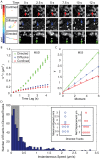Imaging the directed transport of single engineered RNA transcripts in real-time using ratiometric bimolecular beacons
- PMID: 24454933
- PMCID: PMC3893274
- DOI: 10.1371/journal.pone.0085813
Imaging the directed transport of single engineered RNA transcripts in real-time using ratiometric bimolecular beacons
Abstract
The relationship between RNA expression and cell function can often be difficult to decipher due to the presence of both temporal and sub-cellular processing of RNA. These intricacies of RNA regulation can often be overlooked when only acquiring global measurements of RNA expression. This has led to development of several tools that allow for the real-time imaging of individual engineered RNA transcripts in living cells. Here, we describe a new technique that utilizes an oligonucleotide-based probe, ratiometric bimolecular beacon (RBMB), to image RNA transcripts that were engineered to contain 96-tandem repeats of the RBMB target sequence in the 3'-untranslated region. Binding of RBMBs to the target RNA resulted in discrete bright fluorescent spots, representing individual transcripts, that could be imaged in real-time. Since RBMBs are a synthetic probe, the use of photostable, bright, and red-shifted fluorophores led to a high signal-to-background. RNA motion was readily characterized by both mean squared displacement and moment scaling spectrum analyses. These analyses revealed clear examples of directed, Brownian, and subdiffusive movements.
Conflict of interest statement
Figures


Similar articles
-
Real-time imaging of single engineered RNA transcripts in living cells using ratiometric bimolecular beacons.J Vis Exp. 2014 Aug 6;(90):e51544. doi: 10.3791/51544. J Vis Exp. 2014. PMID: 25146531 Free PMC article.
-
Quantitative assessment of ratiometric bimolecular beacons as a tool for imaging single engineered RNA transcripts and measuring gene expression in living cells.Nucleic Acids Res. 2013 Aug;41(15):e152. doi: 10.1093/nar/gkt561. Epub 2013 Jun 27. Nucleic Acids Res. 2013. PMID: 23814183 Free PMC article.
-
Ratiometric bimolecular beacons for the sensitive detection of RNA in single living cells.Nucleic Acids Res. 2010 Aug;38(14):e148. doi: 10.1093/nar/gkq436. Epub 2010 May 27. Nucleic Acids Res. 2010. PMID: 20507905 Free PMC article.
-
Engineering Novel Molecular Beacon Constructs to Study Intracellular RNA Dynamics and Localization.Genomics Proteomics Bioinformatics. 2017 Oct;15(5):279-286. doi: 10.1016/j.gpb.2017.04.004. Epub 2017 Sep 21. Genomics Proteomics Bioinformatics. 2017. PMID: 28942262 Free PMC article. Review.
-
Nanostructured probes for RNA detection in living cells.Ann Biomed Eng. 2006 Jan;34(1):39-50. doi: 10.1007/s10439-005-9003-6. Epub 2006 Feb 7. Ann Biomed Eng. 2006. PMID: 16463087 Review.
Cited by
-
Single-cell detection of mRNA expression using nanofountain-probe electroporated molecular beacons.Small. 2015 May;11(20):2386-91. doi: 10.1002/smll.201401137. Epub 2015 Feb 1. Small. 2015. PMID: 25641752 Free PMC article.
-
Imaging of DNA and RNA in Living Eukaryotic Cells to Reveal Spatiotemporal Dynamics of Gene Expression.Annu Rev Biochem. 2020 Jun 20;89:159-187. doi: 10.1146/annurev-biochem-011520-104955. Epub 2020 Mar 16. Annu Rev Biochem. 2020. PMID: 32176523 Free PMC article. Review.
-
Inside single cells: quantitative analysis with advanced optics and nanomaterials.Wiley Interdiscip Rev Nanomed Nanobiotechnol. 2015 May-Jun;7(3):387-407. doi: 10.1002/wnan.1321. Epub 2014 Nov 27. Wiley Interdiscip Rev Nanomed Nanobiotechnol. 2015. PMID: 25430077 Free PMC article. Review.
-
Nucleic Acid Strand Displacement with Synthetic mRNA Inputs in Living Mammalian Cells.ACS Synth Biol. 2018 Dec 21;7(12):2737-2741. doi: 10.1021/acssynbio.8b00288. Epub 2018 Nov 20. ACS Synth Biol. 2018. PMID: 30441897 Free PMC article.
-
Recent Advances in the Molecular Beacon Technology for Live-Cell Single-Molecule Imaging.iScience. 2020 Nov 13;23(12):101801. doi: 10.1016/j.isci.2020.101801. eCollection 2020 Dec 18. iScience. 2020. PMID: 33299972 Free PMC article. Review.
References
-
- Tyagi S (2009) Imaging intracellular RNA distribution and dynamics in living cells. Nat Methods 6: 331–338. - PubMed
-
- Cha BJ, Koppetsch BS, Theurkauf WE (2001) In vivo analysis of Drosophila bicoid mRNA localization reveals a novel microtubule-dependent axis specification pathway. Cell 106: 35–46. - PubMed
-
- Ishihama Y, Funatsu T (2009) Single molecule tracking of quantum dot-labeled mRNAs in a cell nucleus. Biochem Biophys Res Commun 381: 33–38. - PubMed
Publication types
MeSH terms
Substances
Grants and funding
LinkOut - more resources
Full Text Sources
Other Literature Sources

